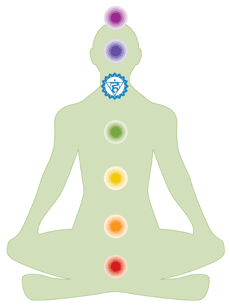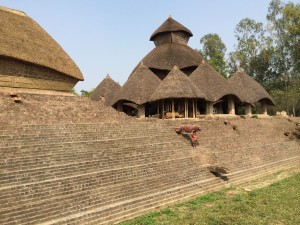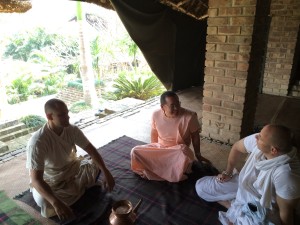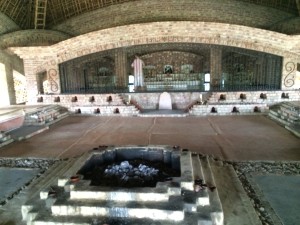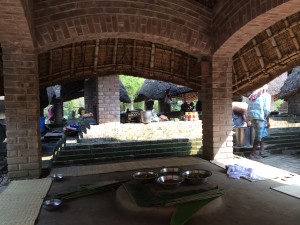Kripamoya Prabhu at Kirtan Mela Mayapur 2014 Day 2
Kripamoya Prabhu at Kirtan Mela Mayapur 2014 Day 2
Do the daivi maya in Gita 7.14 and daivi prakriti in 9.13 to the same thing or different things?
→ The Spiritual Scientist
I am a Physics student. How can I study the Bhagavad-gita scientifically when it seems like a discussion in a story?
→ The Spiritual Scientist
True colours
→ KKSBlog
(Kadamba Kanana Swami, 14 March 2009, Korsnas, Sweden, Srimad Bhagavatam 3.2.15)
Question: Are the faults that we see in others simply a reflection of our own faults or is there something else to it?
 Not always but it can well be. If one is a liberated soul, when one sees faults in others then one sees real faults in others, faults that are there. If one is a conditioned soul then there are two options. One option is that everything one sees is coloured by the glasses of one’s false ego. The false ego gives us coloured glasses where everything is coloured by them. In that case, we see faults in a person and we add a little colour from our own false ego to it as well. Thus we make faults into something more than what is really there. We take what is there and then add something. That is looking at faults through false ego. The other option is that there are no faults at all, and that we just project with our false ego faults onto someone.
Not always but it can well be. If one is a liberated soul, when one sees faults in others then one sees real faults in others, faults that are there. If one is a conditioned soul then there are two options. One option is that everything one sees is coloured by the glasses of one’s false ego. The false ego gives us coloured glasses where everything is coloured by them. In that case, we see faults in a person and we add a little colour from our own false ego to it as well. Thus we make faults into something more than what is really there. We take what is there and then add something. That is looking at faults through false ego. The other option is that there are no faults at all, and that we just project with our false ego faults onto someone.
So these possibilities are there for the conditioned soul – first is that there are real faults but they are coloured, and other times there are no faults but they come from projections of our false ego. But in the case of a liberated soul, he sees things as they are because he is completely sober and he can see right through you and he sees everything at the glance: the faults, the good qualities – but with compassion, with unlimited compassion.
Meaning Of The Names PT.10
→ Japa Group
Sri Gaura purnima Shobha Yatra in ISKCON-Delhi (Album 117 photos)
→ Dandavats.com
 Gaura Purnima is a Gaudiya Vaishanva festival that celebrates the divine appearance of Lord Caitanya Mahaprabhu in Navadwipa, India. Gaura Purnima means “Golden Full Moon”. The name signifies that Lord Caitanya took birth at time of full moon and He blesses everyone with the moonlike rays of His teachings. Festivities at ISKCON Delhi include a shobha-yatra (parade) with utsava murti of Sri Sri Gaura Nitai on Juhu beach followed by Sringar-arati and lecture on the glories of Sri Chaitanya Mahaprasad. The evening festivities consist of maha-abhishek of Sri Sri Gaura Nitai, Sri Gaura arati followed by dinner prasada for all. Read more ›
Gaura Purnima is a Gaudiya Vaishanva festival that celebrates the divine appearance of Lord Caitanya Mahaprabhu in Navadwipa, India. Gaura Purnima means “Golden Full Moon”. The name signifies that Lord Caitanya took birth at time of full moon and He blesses everyone with the moonlike rays of His teachings. Festivities at ISKCON Delhi include a shobha-yatra (parade) with utsava murti of Sri Sri Gaura Nitai on Juhu beach followed by Sringar-arati and lecture on the glories of Sri Chaitanya Mahaprasad. The evening festivities consist of maha-abhishek of Sri Sri Gaura Nitai, Sri Gaura arati followed by dinner prasada for all. Read more › March 2014
→ 16 ROUNDS to Samadhi magazine
If Karna was not stronger than Arjuna why did Kunti weaken him emotionally and Indra weaken him physically before the war?
→ The Spiritual Scientist
Karna’s colossal blunder
→ The Spiritual Scientist
In the Mahabharata, why are other warriors like Eklavya Ghatothakcha and Babruvahana manipulated to favor Arjuna?
→ The Spiritual Scientist
Prabhupada Letters :: Anthology 2014-03-16 12:44:00 →
"Dashami. No letter received. In the evening there was meeting. The attendance was three. Joan was kind enough to get my books sixteen sets from Paragon Book Gallery. The books are brought and kept in stock. No expenditure. Income $3.00 by contribution."
Prabhupada Letters :: 1966
Prabhupada Letters :: Anthology 2014-03-16 12:42:00 →
Prabhupada Letters :: 1969
Prabhupada Letters :: Anthology 2014-03-16 12:36:00 →
Prabhupada Letters :: 1969
Clearing My Throat
→ Seed of Devotion
A friend of mine recently told me that I often clear my throat. In fact, over the years I have had the constant experience of losing my voice. As one of the seven chakras is located in the throat - the capacity to communicate and share the self - I find it no surprise that I have had a rocky relationship with my voice.
I want to communicate something, anything, and although so much beauty has been transpiring in my life, I'm at a loss. More and more, I'm at a loss. I'm frustrated and angry that I refrain from communicating even on Facebook or an email thread. I'm afraid of no one getting me, no one listening, no one caring.
I realized this morning that not trying is painful, but to try and fail is even more painful.
But to withhold is to perish. This morning I felt like I was going to explode.
I am praying to my dear gurudeva and my beloved Lord that somehow or other They may allow me to communicate my heart.
Prabhupada Letters :: Anthology 2014-03-16 12:31:00 →
Prabhupada Letters :: 1969
Sri Krishna Chaitanya (Gauranga) Mahaprabhu (Album 47 paintings)
→ Dandavats.com
 Mahaprabhu was a beautiful child, and the ladies of the town came to see Him with presents. His mother's father, Pandita Nilambara Cakravarti, a renowned astrologer, foretold that the child would be a great personage in time; and he, therefore, gave him the name Visvambhara. The ladies of the neighbourhood styled him Gaurahari on account of His golden complexion, and His mother called Him Nimai on account of the 'nimba' tree near which He was born. Beautiful as the lad was, everyone heartily loved to see Him every day. As He grew up He became a whimsical and frolicsome lad. After His fifth year, He was admitted into a pathasala where He picked up Bengali in a very short time. Read more ›
Mahaprabhu was a beautiful child, and the ladies of the town came to see Him with presents. His mother's father, Pandita Nilambara Cakravarti, a renowned astrologer, foretold that the child would be a great personage in time; and he, therefore, gave him the name Visvambhara. The ladies of the neighbourhood styled him Gaurahari on account of His golden complexion, and His mother called Him Nimai on account of the 'nimba' tree near which He was born. Beautiful as the lad was, everyone heartily loved to see Him every day. As He grew up He became a whimsical and frolicsome lad. After His fifth year, He was admitted into a pathasala where He picked up Bengali in a very short time. Read more › Prabhupada Letters :: Anthology 2014-03-16 12:26:00 →
Prabhupada Letters :: 1970
March 16th, 2014 – Gaura Purnima Darshan
→ Mayapur.com
The post March 16th, 2014 – Gaura Purnima Darshan appeared first on Mayapur.com.
Prabhupada Letters :: Anthology 2014-03-16 12:04:00 →
Prabhupada Letters :: 1971
Prabhupada Letters :: Anthology 2014-03-16 12:02:00 →
Prabhupada Letters :: 1974
Prabhupada Letters :: Anthology 2014-03-16 11:59:00 →
Prabhupada Letters :: 1974
Sivarama Swami reading Act One of Caitanya Candradoya Nataka – The Entrance of His Bliss
→ SivaramaSwami.com
The post Sivarama Swami reading Act One of Caitanya Candradoya Nataka – The Entrance of His Bliss appeared first on SivaramaSwami.com.
Worshipping the very source of our life force and consciousness – Krsna Caitanya
→ SivaramaSwami.com
The post Worshipping the very source of our life force and consciousness – Krsna Caitanya appeared first on SivaramaSwami.com.
The Glories of Lord Caitanya
→ HH Bhakti Caitanya Swami
My Sacred Duty
→ travelingmonk.com
Sri Gaura Purnima celebration and Initiation Ceremony in Hong-Kong (Album 314 photos)
→ Dandavats.com
 With Keshava Bharati Goswami Read more ›
With Keshava Bharati Goswami Read more › Doing arotika to the ancient deities of Kathmandu, Nepal (Album 220 photos)
→ Dandavats.com
 Photography by Ananta Vrindavan dasa Read more ›
Photography by Ananta Vrindavan dasa Read more › Reviving Love 1 – Para dharma contrasted with apara dharmas like patriotism, be-good and service to parents
→ The Spiritual Scientist
The four P’s of effective chanting – Posture, Pronunciation, Purity and Prayerfulness
→ The Spiritual Scientist
Bhakti Anantha Krishna Swami at Kirtan Mela Mayapur 2014 Day 3
→ Gouranga TV - The Hare Krishna video collection
Bhakti Anantha Krishna Swami at Kirtan Mela Mayapur 2014 Day 3
New Vrindaban’s Palace of Gold Honored – Back to Godhead Magazine – October 1980
→ New Vrindaban Brijabasi Spirit
New Vrindaban’s Palace of Gold Honored – Back to Godhead Magazine – October 1980.
By William Robins
Limestone, W. Va., Aug. 5

Hare Krsna Devotees Cool Off in Fountain in The Garden at Palace Of Gold
The men in saffron robes, in denims and faded shirts, heads shaven and unshaven, the women in saris of many colors, the Hare Krishna devotees came in twos and threes and troops, afoot and in Jeeps and in panel trucks; and old cars.
And as they rounded a bend in the narrow mountain road they beheld, rising like a mirage above the trees here in rural West Virginia, the gold-leafed domes and spires of a vision of spectacular opulence, the Palace of Gold, whose construction they had come to celebrate.
From across the United States and from Canada, Mexico and India as well, many of these members of the International Society for Krishna Consciousness were arriving to join a 300-member community of the faithful here for the second annual Prabhupada Summer Festival, which ends tomorrow.
It has also been proclaimed by some to be a grand opening of the palace, though their swami described it as only a preview for a grand opening scheduled for Labor Day weekend. The palace is the first of many religious shrines to be built here in a community the devotees have named New Vrindaban, for a sacred city of temples in India.
However they regarded the occasion, visitors stared with awe as if at a miracle of creation atop a ridge overlooking miles of forests and fields, foothills and valleys. But again their spiritual leader was more restrained.
“This was not a very difficult thing to do,” he said in an interview. “Nothing is very difficult when the Lord is in your heart. Without Him it would be impossible.”
The rain showers marred opening festivities late yesterday when an opening address by the swami and a vegetarian feast, both scheduled for the grassy hillsides, were driven under shelter. But today, unperturbed, the devotees resumed, from before dawn till after dark, their three days of rituals and seminars, interspersed with strolls to the palace and visits to a bazaar under a multicolored canopy, much like a country fair, where they could buy refreshments and visit educational booths and stalls selling their literature.
This is the second of three celebrations of the construction of the palace. The first, last September, was a dedication. When the third occurs, on the occasion of a festival named Janmastami over the Labor Day weekend, the finishing work will still be continuing, with devotees bending and carefully brushing gold leaf onto intricate relief work of walls, columns and steps.
On a site that was once a garbage dump, the devotees were climbing broad steps to walled terraces looking down on development of a Garden of Time to be dotted with fountains symbolic of phases of human life and out over construction work on a restaurant and museum toward broad acres on the ridge top where still another garden is to be created. As they walked they chanted the names of deities.
Over all this rises the ornate palace, built as a memorial to A.C. Bhaktivedanta Swami Prabhupada, the Indian scholar who brought his translations of ancient scriptures in 1965 and began the Hare Krishna movement in this country. Its black and gold leaf walls, inlaid with Italian onyx, are pierced through with intricately decorated stained glass windows, and they support gold and black domes, all an amalgam of Eastern and Renaissance architecture.
Inside, crossing marble floors in geometric mosaics under mirrored ceilings, the devotees finished two shrines to Prabhupada, who died a few years ago.
One is a suite in which sits a couch he once used, adjoining a study where a lifelike figure of the sainted Prabhupada bends over a marble table as if to work on a translation. Adjoining is an onyx, teak, marble and gold bathroom.
The other is a central court, a sacred room where the devotees in small groups knelt and prostrated themselves before another statue, a gold figure of Prabhupada seated on a gold throne under an ornately carved cupola. Overhead the domed ceiling is decorated with paintings depicting the life of their Lord Krishna, including one showing him casting out demons.
All the construction is the work of a small community living on 2,000 acres of the rural countryside and executed in their own craft shops. It has about 300 members now, who have raised by their own efforts the $500,000 spent on it thus far.
What is holding you back?
→ Successful Vaisnavas
This is a powerful video. Authentic sharing.
What are you struggling with?
What are you afraid of?
What do you need to give up to be able to live your destiny?
Let us know in the comments below:
Friday, March 14th, 2014
→ The Walking Monk
Thursday, March 13th, 2014
→ The Walking Monk
Shri Chaitanya Mahaprabhu’s Appearance—The Exoteric and Esoteric Reasons
→ Karnamrita's blog
(this blog is recorded on the full page: quick time player is needed; works best with Firefox or Explorer; if you are using Google Chrome it will automatically play, so to not listen, mute your speakers.)

[reposted a few times from 3-15-14] There are many ways to know a person. One can know a person by guessing what they might, or should, be like, study the person from a distance—say from the Gossip column, Internet, or Facebook— hear about them from others who may, or may not, know them, or we may directly experience the person through a loving personal relationship.
The last way is the best because if we love a person we will discover, and they will reveal to us, all their secrets. It is similar with Krishna. Even though he is both infinite and inconceivable he has the prerogative to reveal himself to those who love him purely and selflessly. In regard to Krishna, and specifically Shri Chaitanya, there is both an exoteric (apparent) as well as an esoteric (hidden) reason for his appearance.
PART ONE, THE CONFIDENTIAL, HIDDEN REASONS:
The closer we come to Krishna the more we will know about him, by his grace. And there are many ways to explain the necessity of the Lord’s various forms and energies. For example, great devotees have looked very carefully at Krishna, and discovered another person, Radha, or devotion personified, who is most dear to Krishna. There is Krishna, and his energies, all of which come from Radha.
And looking even more closely at the Divine Couple, pure devotees have found that Radha and Krishna have combined together to become one, in the person of Shri Chaitanya. Such pure souls, such as the Six Goswami’s of Vrindavan, Shri Krishnadas Kaviraja, and others, have shared their experience with us in their writings, and given us the logic of their love, referenced by the Vedic scriptures.
THE LORD'S DESIRES ARE ALWAYS FULFILLED
If we study the lila, divine activities, of Radha and Krishna as revealed in the Shrimad Bhagavatam and Chaitanya Charitamrita commented on our Gaudiya Vaishnava acharyas including Shrila Prabhupada, we will understand that there must be a Lord Chaitanya to fulfill Krishna’s unmet need. Krishna is perfect, complete, and full in himself, so when he wants to experience something, he manifests a situation and spiritual body accordingly.
Bhaktivedanta Academy
→ Ramai Swami
The Bhaktivedanta Academy, established in 1984, is an educational institution based in Sri Mayapur Dhama, India, which provides education for boys, girls and adult students on the principles of the Vedic Gurukula system.
A tidal wave!
→ KKSBlog
 After taking sannyasa, Lord Caitanya just began to dance in great ecstasy and so did Kesava Bharati; he started to dance along with Lord Caitanya and all the people began to dance.
After taking sannyasa, Lord Caitanya just began to dance in great ecstasy and so did Kesava Bharati; he started to dance along with Lord Caitanya and all the people began to dance.
This was the first public display of such love of God. It just burst out of the heart of Sri Caitanya Mahaprabhu, who had until then always kept his love for Krsna somewhat hidden.
In his youth, he didn’t display it at all, though sometimes as a young man he had problems when he just fell to the ground. Mother Saci thought it was some kind of disease. She called Srivas Thakur who was a close friend of the family. When he saw Nimai in that state, he said, “I wish I would get that disease!” He understood very well what was going on. So, it might have been known to some for some time, but never was it displayed so fully as when he took sannyasa.
Meaning Of The Names PT.9
→ Japa Group

Due to the intense love of Sri Radha, Sri Hari becomes so captivated that His flute falls from His hand. With the desire to enjoy in the forest bowers with Krsna, Radha steals His flute. That goddess is thus famous as Hara.
355. Gaura Purnima lecture
→ 9 Days, 8 Nights
Prabhupada Letters :: Anthology 2014-03-15 17:05:00 →
"Navami. Today no letter received. Deposited in the Bank $25. No other expenditure. In the evening five ladies and gentlemen visited. There was some talks. Mrs. Leblanc is losing interest since she has learnt it that Bhagwat Geeta does not support monism."
Prabhupada Journal :: 1966

